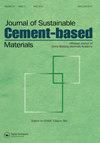粉煤灰GGBFS耐高温修复砂浆
IF 4.2
3区 工程技术
Q1 CONSTRUCTION & BUILDING TECHNOLOGY
Journal of Sustainable Cement-Based Materials
Pub Date : 2022-11-02
DOI:10.1080/21650373.2021.1992682
引用次数: 4
摘要
发展可持续建筑材料对保护资源、减少二氧化碳排放和环境污染具有重要意义。用钙基粘合剂(水泥或石灰)生产的砂浆暴露在火或其他高温下会对其机械性能产生不利影响。此外,高温的作用可能引起孔隙结构的变化,引起开裂和剥落。保护高温下历史建筑的完整性对文化的可持续性至关重要。在本研究中,用15%、30%和60%的粉煤灰(FA)和粒状高炉矿渣(GBFS)代替天然水力石灰(NHL)作为砂浆的粘结剂。在混合物中,还使用1.5%(体积比)的聚丙烯纤维(PF)。试验结果表明,随着FA和GBFS含量的增加,砂浆的和易性增加,而PF降低了砂浆的流动直径。研究结果表明,膏体含量对砂浆的孔隙率和吸水率有影响。随着FA含量的增加,膏体含量增加,孔隙率降低。在90天石灰砂浆中加入30% FA,获得了10 MPa以上的抗压强度。GBFS的加入对混凝土的抗压和抗弯强度均有不利影响。PF由于其微填料作用,降低了砂浆的孔隙率和水渗透深度。基于fa的混合物比基于gbfs的混合物更耐高温。在600℃温度下,fa基混合物的抗压强度在4.3 ~ 8.6 MPa之间。在纤维混合物中,随着温度的升高,质量损失的增量更大。对高温下的砂浆进行XRD和SEM分析,观察到C-S-H凝胶。在暴露于200°C的混合物的体视显微镜图像中观察到PF。由于砂浆的孔隙率较高(19.7% ~ 30.8%),因此在200℃下,混合料中的PF并未完全熔化,而是遭到破坏。因此,在NHL迫击炮中,FA用量为30%,GBFS用量为15%更为合适。本文章由计算机程序翻译,如有差异,请以英文原文为准。
High temperature resistant restoration mortar with fly ash and GGBFS
Nowadays, the development of sustainable building materials is of loom large in for the preserve resources and reducing CO2 emission and environmental pollution effects. Exposure to fire or other high temperatures of mortars produced with calcium-based binders (cement or hydraulic lime) adversely affects their mechanical properties. In addition, the effect of high temperature may cause a change in the pore structures, causing cracking and spalling. Protecting the integrity of historical buildings exposed to high temperatures is important for cultural sustainability. In this study, natural hydraulic lime (NHL) used as a binder in mortars was replaced with 15, 30 and 60% fly ash (FA) and granulated blast furnace slag (GBFS). In the mixtures, 1.5% (by volume) polypropylene fiber (PF) was also used. Test results reveal that while the mortars’ workability increased as the FA and GBFS content increased, PF decreased the flow diameters of the mortars. It has been determined that the paste content affects the porosity and water absorption rates of mortars. With the addition of FA content, paste content increased and porosity reduced. Compressive strength over 10 MPa was obtained by using 30% FA in 90-day lime mortars. As the addition of GBFS, the compressive and flexural strength were negatively affected. PF has reduced the porosity and water penetration depth of the mortars thanks to its micro filler effect. FA-based mixtures were more resistant to high temperatures than GBFS-based mixtures. Compressive strength was measured between 4.3 and 8.6 MPa after 600 °C temperature in FA-based mixtures. In fibrous mixtures, increment of mass loss was more with high temperature. C-S-H gels were observed in XRD and SEM analyzes of mortars exposed to high temperatures. PF was observed in stereomicroscope images of mixtures exposed to 200 °C. Since the porosity of the mortars is relatively high (19.7%–30.8%), the PF in the mixtures exposed to 200 °C did not melt completely but was damaged. As a result, it would be more appropriate to use 30% of FA and 15% of GBFS in NHL mortars.
求助全文
通过发布文献求助,成功后即可免费获取论文全文。
去求助
来源期刊
CiteScore
6.60
自引率
15.90%
发文量
71
期刊介绍:
The Journal of Sustainable Cement-Based Materials aims to publish theoretical and applied researches on materials, products and structures that incorporate cement. The journal is a forum for discussion of research on manufacture, hydration and performance of cement-based materials; novel experimental techniques; the latest analytical and modelling methods; the examination and the diagnosis of real cement and concrete structures; and the potential for improved cement-based materials. The journal welcomes original research papers, major reviews, rapid communications and selected conference papers. The Journal of Sustainable Cement-Based Materials covers a wide range of topics within its subject category, including but are not limited to: • raw materials and manufacture of cement • mixing, rheology and hydration • admixtures • structural characteristics and performance of cement-based materials • characterisation techniques and modeling • use of fibre in cement based-materials • degradation and repair of cement-based materials • novel testing techniques and applications • waste management

 求助内容:
求助内容: 应助结果提醒方式:
应助结果提醒方式:


